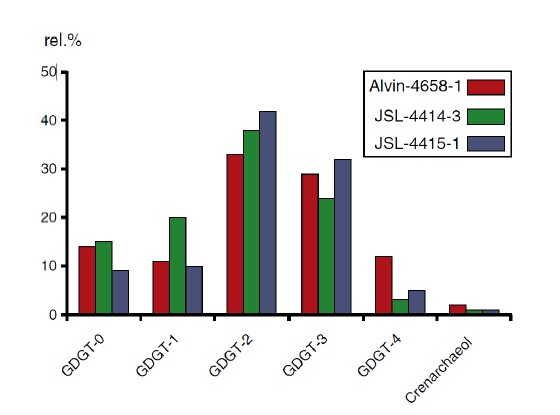
Research Reveals time Integrated Variation of Sources of Fluids, Seepage Dynamics, and Mechanisms of Trace Metal Enrichment
Aug 26, 2014 Email"> PrintText Size

New studies conducted by an international team led by scientists from South China Sea Institute of Oceanology (SCSIO) of the Chinese Academy of Sciences have found time integrated variation of sources of fluids, seepage dynamics, and mechanisms of trace metal enrichment archived in authigenic carbonate from cold hydrocarbon seeps.
Careful examination has revealed the diversity of stable carbon and oxygen isotopes, and mineral compositions in MC118 carbonates. The study also found that biomarker patterns of methanotrophs and methanogens preserved in seep carbonates. Such diversities were interpreted to reflect changes in seepage flux and in the composition of seepage fluids over time. The findings suggest that methane production at seeps, an environment typified by anaerobic oxidation of methane, might be a common, yet sometimes overlooked process.

Figure 1. Relative percentages of glycerol dibiphytanyl glycerol tetraethers (GDGT) in three carbonate samples from MC118 (Gulf of Mexico). (Image by SCSIO)
Recent work on seep carbonates revealed variable Ce anomalies and anomalous enrichments of certain trace metals. However, the mechanisms accounting for such anomalies remain poorly constrained. Researchers from SCSIO found that the covariation of Mo with U, including authigenic Mo and U enrichments proved useful to obtain new insight into the applicability of Ce anomalies to constrain past redox conditions. The study also found that iron oxyhydroxides played an important role in the adsorption of Mo, As, and Sb in the water column and their transfer to the sediment. Similar processes and scenarios may apply to other modern and fossil cold seep sites.

Figure 2. Schematic diagram illustrating the adsorption and transportation process of Mo, As, and Sb and MREE. (Image by SCSIO)
The results have been published in Chemical Geology. The research was supported by the “Hundred Talents Program” of Chinese Academy of Sciences and National Natural Science Foundation of China.
References:
New studies conducted by an international team led by scientists from South China Sea Institute of Oceanology (SCSIO) of the Chinese Academy of Sciences have found time integrated variation of sources of fluids, seepage dynamics, and mechanisms of trace metal enrichment archived in authigenic carbonate from cold hydrocarbon seeps.
Careful examination has revealed the diversity of stable carbon and oxygen isotopes, and mineral compositions in MC118 carbonates. The study also found that biomarker patterns of methanotrophs and methanogens preserved in seep carbonates. Such diversities were interpreted to reflect changes in seepage flux and in the composition of seepage fluids over time. The findings suggest that methane production at seeps, an environment typified by anaerobic oxidation of methane, might be a common, yet sometimes overlooked process.

Figure 1. Relative percentages of glycerol dibiphytanyl glycerol tetraethers (GDGT) in three carbonate samples from MC118 (Gulf of Mexico). (Image by SCSIO)
Recent work on seep carbonates revealed variable Ce anomalies and anomalous enrichments of certain trace metals. However, the mechanisms accounting for such anomalies remain poorly constrained. Researchers from SCSIO found that the covariation of Mo with U, including authigenic Mo and U enrichments proved useful to obtain new insight into the applicability of Ce anomalies to constrain past redox conditions. The study also found that iron oxyhydroxides played an important role in the adsorption of Mo, As, and Sb in the water column and their transfer to the sediment. Similar processes and scenarios may apply to other modern and fossil cold seep sites.

Figure 2. Schematic diagram illustrating the adsorption and transportation process of Mo, As, and Sb and MREE. (Image by SCSIO)
The results have been published in Chemical Geology. The research was supported by the “Hundred Talents Program” of Chinese Academy of Sciences and National Natural Science Foundation of China.
References:
CAS Institutes
There are 124 Institutions directly under the CAS by the end of 2012, with 104 research institutes, five universities & supporting organizations, 12 management organizations that consist of the headquarters and branches, and three other units. Moreover, there are 25 legal entities affiliated and 22 CAS invested holding enterprisesThere are 124 I...>> more
Contact Us

Chinese Academy of Sciences
Add: 52 Sanlihe Rd., Xicheng District, Beijing, China
Postcode: 100864
Tel: 86-10-68597592 (day) 86-10-68597289 (night)
Fax: 86-10-68511095 (day) 86-10-68512458 (night)
E-mail: cas_en@cas.cn

